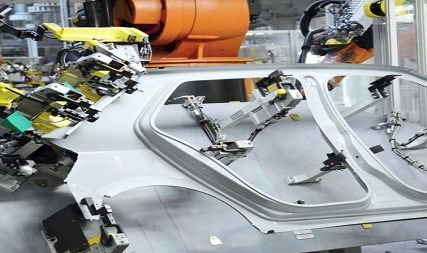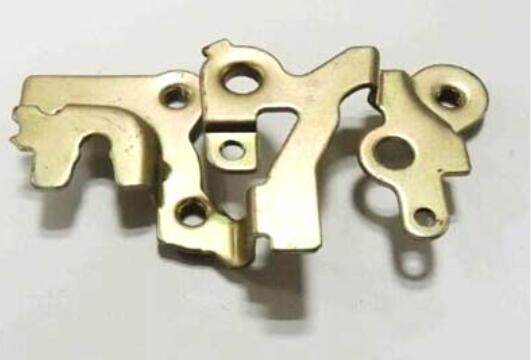How Metal-Stamped Parts Are Used For Automotive Industry
Have you ever wondered how your car’s sleek, smooth contours came? Or how does each intricate part under the hood fit ideally to create that purring engine sound? Well, the answer lies in the art of metal stamping – a process I’ve mastered over the years at Worthy Hardware. It’s not just about shaping metal; it’s about crafting the future of automotive excellence.
In the automotive industry, metal stamping is the unsung hero, pivotal in creating numerous essential components. From the chassis down to the minutest bracket, stamped metal parts form the backbone of every vehicle on the road.
The beauty of metal stamping is its versatility and precision, which are crucial for the automotive industry. As an expert, I’ve seen firsthand how stamped parts revolutionize vehicle manufacturing, making it more efficient, cost-effective, and innovative. Let’s dive deeper into this fascinating world.

Understanding Metal Stamping
Metal stamping, a term that sounds complex, is relatively straightforward. It’s a manufacturing process where high-pressure machinery transforms flat metal sheets into specific shapes.
We turn simple metal sheets into complex parts with incredible precision by applying stamping, punching, cutting, bonding, welding, and thermoforming.
Let me break down these techniques for you:
- Stamping involves placing the metal sheet in a stamping press where it dies to shape the metal.
- Punching: It’s about creating holes or cut-outs in the metal, often used for creating vents or lightweight structures.
- Cutting: Here, we trim the metal to the exact size and shape needed.
- Bonding: Sometimes, we need to join metal parts, and bonding is the way to go.
- Welding: It’s a more robust way of fusing metal parts, ensuring they stay under high stress.
- Thermoforming: This involves heating the metal to make it more pliable before shaping it, which is used for more complex shapes.
Advantages of Metal Stamping in Automotive Manufacturing
Now, why is metal stamping such a big deal in automotive manufacturing? Here are the key advantages:
- High Precision and Consistency: Cars need parts that fit together perfectly. We achieve this precision with metal stamping, ensuring each part is a carbon copy of the last.
- Efficiency and Speed: Time is money, especially in the automotive world. Metal stamping allows for the rapid production of large parts, keeping assembly lines moving smoothly.
- Cost-Effectiveness: It’s not just about making parts quickly; it’s about doing it cost-effectively. Stamping reduces material waste and requires less labor, which translates to savings for the manufacturer.
- Versatility: Metal stamping can handle everything, whether a tiny bracket or a large panel. This versatility is crucial in an industry that constantly evolves and demands a wide range of parts.
- Strength and Durability: Last but not least, stamped parts are vital. They must withstand all sorts of stresses and strains, and metal stamping ensures they do just that.
The Role of Metal Stamped Parts in Automobiles

Metal-stamped parts are the unsung heroes in the anatomy of automobiles. Though often unseen, these components are integral to the functionality and safety of every vehicle on the road. At Worthy Hardware, we understand the critical role each of these parts plays, and our precision engineering reflects this in every piece we produce.
Key Applications in Vehicles
Let’s explore some of the primary applications of metal-stamped parts in vehicles.
- Body Panels: The exterior of your car – the doors, hood, trunk lid, and fenders – are all products of metal stamping. These panels not only define the aesthetics of your vehicle but also contribute to its structural integrity and aerodynamics.
- Engine Components: Critical parts in the engine, like cylinder heads, exhaust manifolds, and valve covers, are made using metal stamping. These components must withstand high temperatures and pressures, making the precision of stamping invaluable.
- Transmission Parts: Gears, clutches, and housings within the transmission system are also crafted through metal stamping. The accuracy and strength of these parts are crucial for the smooth operation and longevity of the transmission system.
- Structural Components: The vehicle’s frame, including cross members and chassis components, relies heavily on stamped parts. These elements form the skeleton of your vehicle, ensuring safety and stability.
- Interior Features: Metal stamping often creates elements like brackets, mounts, and housings for electronic systems in the car’s interior. These parts might be small, but their role in the functionality and ergonomics of the vehicle’s interior is significant.
- Suspension Systems: Components in the suspension system, like spring seats, control arms, and brackets, are typically produced using metal stamping. These parts must be solid and flexible to maintain vehicle stability and passenger comfort.
- Safety Components: Crucial safety features such as seatbelt components, airbag housings, and brackets for safety systems are manufactured using metal stamping. The reliability of these parts is non-negotiable, as they play a direct role in protecting passengers.
Conclusion
In wrapping up, it’s clear that metal-stamped parts are not just components; they are the building blocks of the automotive industry. Each piece, no matter how small, plays a crucial role in a vehicle’s overall functionality, safety, and efficiency. At Worthy Hardware, we take immense pride in our contribution to this dynamic industry. Our commitment to precision, quality, and innovation drives us to deliver the best metal stamping solutions consistently.
Ready to elevate your automotive manufacturing with precision-stamped parts? Reach out to us at Worthy Hardware. Let’s collaborate to create automotive solutions that are not just effective but exemplary. Visit our website or contact our team directly to discuss your needs and how we can fulfill them.

